Asus Eee Pad Transformer Prime Review
Asus Eee Pad Transformer Prime
Lighter and thinner yet more powerful than most rivals, the world’s first quad-core tablet sports a stunning screen, gorgeous design and comes with a keyboard dock.
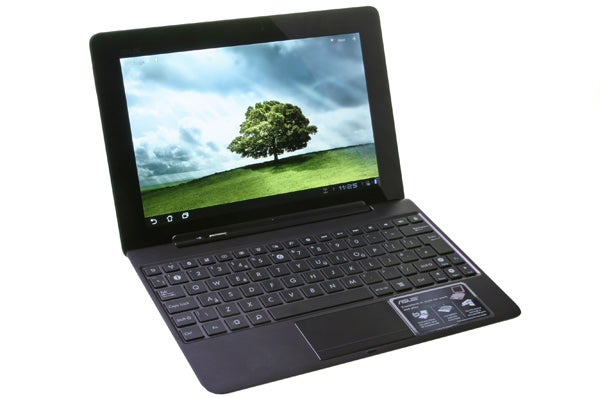
Verdict
Pros
- Thinner and lighter than most
- Gorgeous, super-bright IPS screen
- Quad-core yet excellent battery life
- Keyboard dock adds connectivity and battery
- Full HD video plays smoothly
Cons
- Dock’s keyboard inferior to original Transformer
- Metal finish relatively smudge-prone and slippery
- Top-heavy docked design requires care on lap
- Poor speaker positioning
- App selection still inferior to iPad
- No 3G (yet)
Key Specifications
- Review Price: £499.00
- 10.1in SuperIPS 1,280 x 800 screen
- Tegra 3, 1GB RAM, up to 64GB storage
- Detachable keyboard dock with battery
- MicroHDMI, microSD, SDHC, USB 2.0
- Up to 14hrs battery without dock
Want the cheaper alternative? Read our Transformer Pad 300 review.
But now its reign is about to be ended, by none other than Asus’ own Transformer Prime, AKA the TF201. This sequel to the Transformer is lighter, slimmer, more stylish, metal-clad, comes with an even better screen and, perhaps most significantly, with a quad-core CPU and 12-core GPU combo courtesy of Nvidia’s Tegra 3, making it the most versatile and powerful tablet on the market. 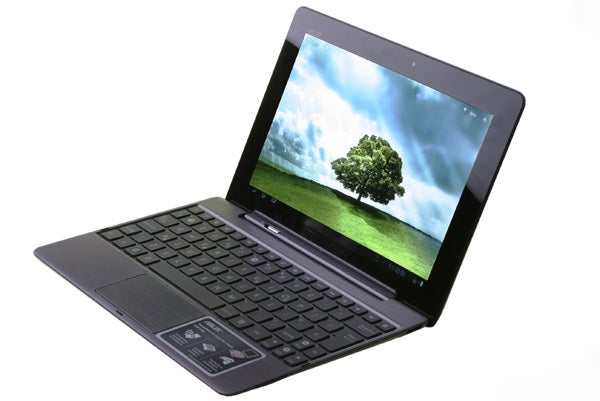
Even without its keyboard dock, the new Asus Eee Pad Transformer Prime is a stunning device. In the inevitable iPad 2 comparison, it holds up very well indeed, as you’ll see if you have a read of our Transformer Prime VS iPad 2: Battle of the Tablet Titans article. Just to sum up, the new Asus Eee Pad Transformer Prime is both thinner and lighter, its metal chassis feels almost as sturdy and it looks just as good as Apple’s effort. It also offers better connectivity, more powerful specifications, superior cameras and, most strikingly, a sharper screen which literally outshines all competitors thanks to its 600nits brightness. 
As the Asus Transformer Prime is also the first quad-core tablet in the world, it’s potentially more powerful than nearly any rival – barring Windows tabs like the Samsung Series 7 Slate, which costs more than double at £999. We’ll explore the full performance in a bit, but suffice to say that there’s more untapped potential here than most developers will know what to do with – oh, and HD video of all varieties will finally play back smoothly, a feat hitherto unmatched in tablet land. 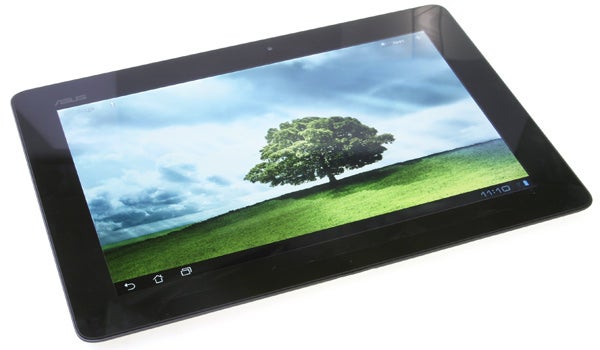
With Asus having committed to updating the Transformer Prime’s Android 3.2 (Honeycomb) to Android 4.0 (Ice Cream Sandwhich AKA ICS) very soon, the current lack of a 3G model is our only real gripe with the latest Asus Eee Pad Transformer – on paper. Mind you, it’s likely there’ll be a 3G version coming out further down the line, and with the keyboard dock attached it’s easy enough to plug in a dongle or tether your phone, but for now it is still a potential issue. With all that out of the way, let’s find out if the Asus Eee Pad Transformer Prime is as good as it appears to be…
As a piece of design, Asus’ new Transformer is – in a word – stunning. It’s difficult to believe that the company managed to stuff all that performance goodness and connectivity into a glass and metal sliver no thicker than a biro. 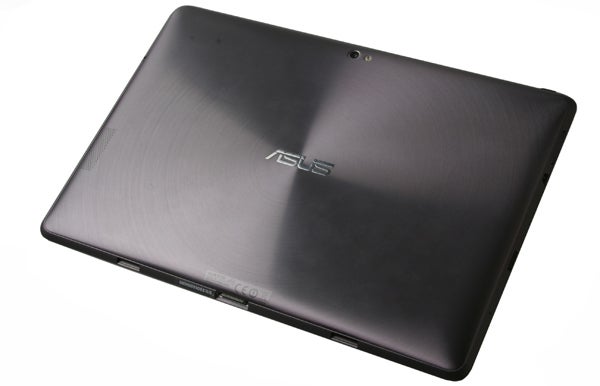
The Zenbook-like concentric ring pattern subtly etched onto its metal back is a matter of personal taste, but we rather like the effect. And it does help to disguise fingerprints just a little, though these can still be very visible depending on the angle. Naturally, the single-sheet Gorilla glass front also picks up prints and smudges despite its anti-fingerprint coating. But that’s a failing shared by nearly all tablets, and at least Asus is kind enough to include a lint-free cleaning cloth.
Though it doesn’t feel quite as solid as an iPad, build quality on the Prime is still impeccable. The metal back is perfectly smooth despite its pattern, and provides reasonable grip. For purely practical purposes we might have preferred a soft-touch finish like on the Lenovo ThinkPad Tablet (review coming soon), but then it wouldn’t have looked as premium. Regardless, it’s still a comfortable device to hold thanks to its smoothly tapered edges and light weight. 
The Prime is available in two colours: Amethyst Gray or Champagne Gold. We chose the former as it’s the more discreet of the two. Its colour isn’t as garish as some of the press shots might have led you to believe, being closer to dark grey than purple. Still, despite offering something different from the crowd and making for a vast improvement over the nondescript brown of the original Transformer, we can’t help but wish Asus had stuck to the more traditional black or silver choices. Mind you, it says a lot for a tablet if its choice of colours is our only (minor) gripe.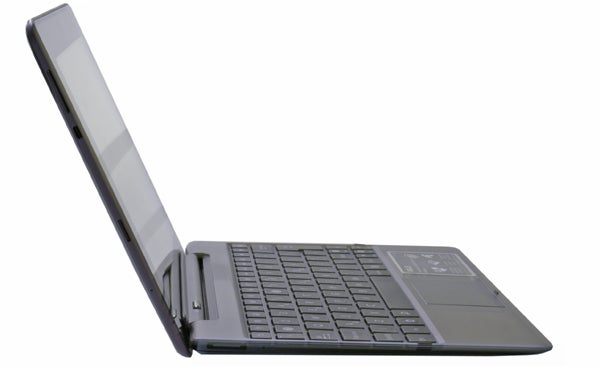
The new dock, meanwhile, has been slimmed down to match the tablet, meaning there’s no way you’ll be able to use the Prime with your old dock even though they share the same connector – trust us, we tried. As with the tablet, build quality is superb and the docking process is as easy as clicking it in. When you want to disconnect the two, simply press the release switch and they come apart just as effortlessly. When the two parts are attached they form a harmonious whole that most people wouldn’t tell apart from a ‘proper’ ultraportable laptop like the 11in MacBook Air.
Connectivity and physical controls on the Prime as a tablet alone are about average for a slim designer model. Along the left edge you’ll find a hard-plastic volume rocker, microHDMI port, and microSD card reader. Along the top is the power button while the 3.5mm headphone jack is located on the right side. Along the bottom there are two slots that fit with locks on the keyboard dock, to either side of the Transformer’s proprietary 40-pin power and data connector. This has remained unchanged from the original Transformer, so you’ll be able to use your old charger if you own one. 
So without its keyboard base, the Prime’s connectivity is about what you would expect. It’s superior to its closest rivals, the iPad 2 and Samsung Galaxy Tab 10.1, but inferior to the likes of the Toshiba AT200 or heavyweights such as the Lenovo ThinkPad Tablet. 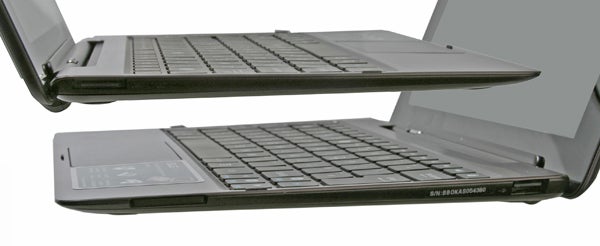
However, throw in the dock and all that changes, thanks to a full-size USB 2.0 port and SDHC card reader. With the twin memory card readers of the tablet and base you could potentially get a whopping 256GB of storage onto this device, and even more using a memory stick. Our only regret is that the dock’s slimming diet has apparently forced Asus to give up the second USB port of the original. We’re all for attractive design, but only if it doesn’t compromise usability (especially over previous generation products).
Of course the dock also adds to the tablet’s longevity as it has a battery built-in (though again this isn’t as impressive as with the original since its capacity is no longer equal to the tablet’s), but we’ll get to how long the Transformer lasts on the go in a bit. The main purpose of the dock is to give you a physical keyboard and touchpad, greatly enhancing potential productivity. 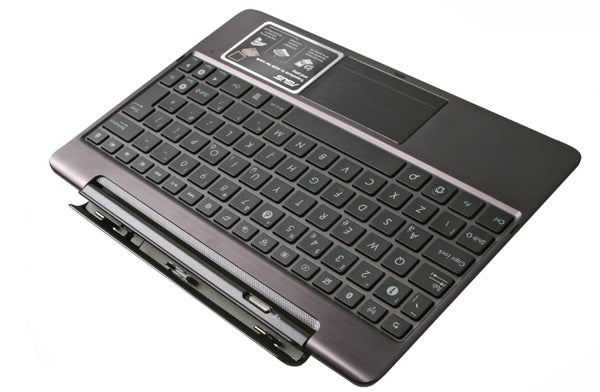
Unfortunately, the chiclet keyboard is yet another aspect that has suffered compared to that of the original dock. Given the Prime is actually a few millimetres narrower than its predecessor, it’s no surprise that keys are just as cramped, despite examples like the HP Compaq Mini proving that it’s still possible to implement a larger layout on such a small device. However, not only is the Prime’s layout unchanged from its predecessor (including the annoyingly small right-shift key), but due to the slimmer profile key action is even more shallow than before, making constant typing almost uncomfortable for extended periods.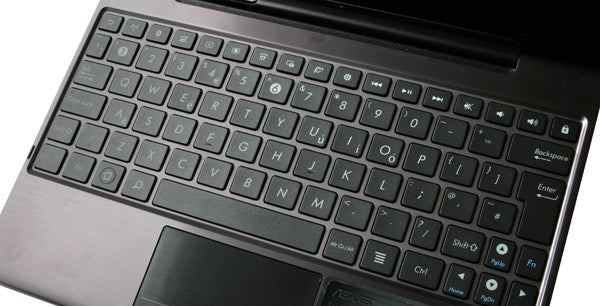
Don’t get us wrong, it’s usable and preferable to most third-party keyboard add-ons for tablets, but it’s definitely an area where many netbooks still have the edge. It’s also worth noting that the new Transformer is more top-heavy than its predecessor as the dock weighs less, so you have to be extra careful not to let it tilt off your lap.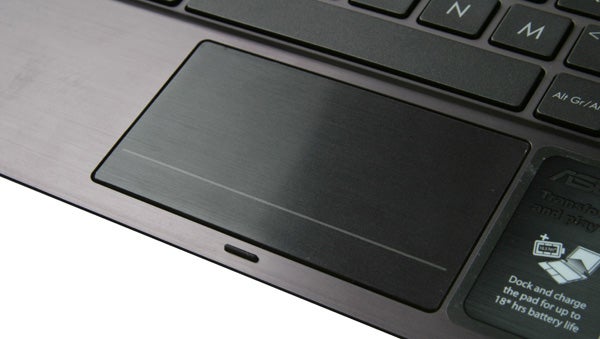
With the touchpad, meanwhile, we have some good and some bad news, depending on how you use it. This time round Asus has gone for a ‘buttonless’ pad of the type found on Apple’s laptops and Ultrabooks like the Acer Aspire S3. The pad itself is smooth and responsive, and with the ‘buttons’ included its area is equal to the pad on the Transformer. Unfortunately, the clickable areas of the pad are very far towards the corners, leaving a large dead-zone in the centre and making them harder to use than the original’s buttons. Whether you find this an annoyance will depend on if you use them at all or just ‘tap to click’. And of course, you can always resort to touching the screen.
It might be a long time before cameras on tablets will match up to the best examples mobile phones can offer, but for now the one on the Transformer Prime’s rear is leading the pack. The 8MP shooter features a back-illuminated CMOS sensor with an F2.8 aperture and LED flash, and supports dynamic auto-focus. 

It takes usable photos, especially in good light, and also lets you record video in up to 1080p where most tablets ‘only’ support 720p.
The Transformer Prime’s 10.1in, 1,280 x 800 screen is even more impressive. To say it’s the best we’ve yet seen on any tablet is an understatement, and it actually justifies Asus’ marketing hype of calling it Super IPS. Viewing angles are as close to flawless as LCD gets, with hardly any noticeable shifts in colours or contrast. Dark detailing is good (if not quite perfect) and blacks are deep, all without compromising the brilliantly bright whites. There are no backlighting issues or bleed to spoil the party either.
With its retina-searing 600nits brightness this is also one of the few tablets that’s actually usable in sunlight, and regardless of the kind of content you’re consuming, Asus’ latest Android effort makes it all look vibrant and almost three-dimensional. It’s a real pity the Transformer doesn’t support a pressure-sensitive stylus (like the Wacom one used on Samsung’s Galaxy Note or the N-Trig supported by the Lenovo ThinkPad and HTC Flyer) as this is the kind of quality display anyone editing photos or creating illustrations would want.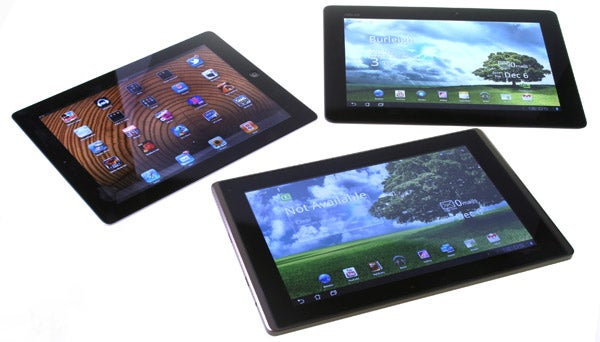
(centre) You can see the relative screen brightness compared to the original Transformer and iPad 2 in this shot. The iPad is on the left, the Transformer (TF101) on the bottom and the Transformer Prime (TF201) is top right. (/centre)
Unfortunately the audio doesn’t begin to compare, despite the SonicMaster branding. Though it’s improved over the original Transformer (and indeed superior to most rivals) that’s not exactly saying much. Perhaps the biggest failing with the speaker is that it’s located in the exact area you cover with your right hand while holding the tablet in landscape mode. It’s also worth noting that audio from the headphone jack is on the quiet side, which is an unnecessary annoyance.
While we’re on the topic of entertainment, we’re glad to report that media playback on Tegra 3 is everything we hoped it would be and more. You might have tried playing back HD video on previous tablets (including the first Transformer) to end up with a juddery mess – or, in the case of Full HD 1080p content, a slideshow. Well, no more. Unfortunately Android Honeycomb’s stock player doesn’t support a huge range of video content, but a quick trip to the Android MarketPlace for a trial version of DicePlayer (other media players may also work as long as they support hardware acceleration), and the Prime played back every single test file we threw at it – including a high-bitrate 1080p MKV that even most dedicated hardware media players like the WD TV HD can’t handle! 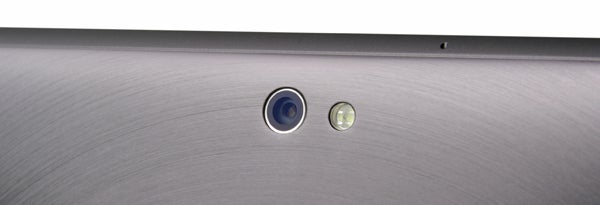
When your tablet plays back video material that dedicated hardware can’t cope with, you know you’re on to a good thing. Hard as Samsung worked to ensure its Tegra 2-based Galaxy Tab 10.1 played back a large portion of 720p content smoothly (above and beyond its rivals including the Apple iPad 2), there were still plenty of limitations. With the quad-core Transformer Prime these are finally a thing of the past. Oh, and did we mention outputting that glorious HD video content to your TV is as easy as plugging in a microHDMI cable? And Tegra 3 gives you enough power to handle 3D video and gaming, so that you can, for example, watch 3D YouTube videos with a compatible monitor or TV? Yep ladies and gentlemen, welcome to your portable HTPC.
Aside from HD video playback, the other area where Tegra 3 really makes its presence felt right now is in gaming. Asus pre-installed some nifty game demos to give a taste of just what Nvidia’s latest and greatest mobile chipset is capable of, and suffice to say we’re impressed. The enhanced version of Riptide GP, for example, shows jaw-dropping water effects: waves now have dynamic whitecaps and highlights, while water splashes convincingly onto the screen. There’s also advanced motion blur when racing at high speeds.
Frankly, running the Tegra 3-optimised version of this game alongside the A5-optimised version for the iPad 2 shows just how much extra power is at play here – though that doesn’t necessarily mean the graphics of Nvidia’s latest will be superior to that of Apple’s in every scenario. In fact, for raw pixel-pushing power the A5 still wins out, and a lot will depend on efficiency of development. Compared to Tegra 2 things are less ambiguous, with the previous-gen chip thoroughly shamed by its successor across the board.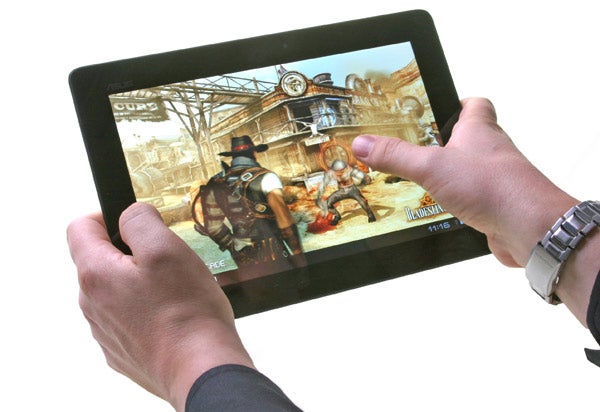
Even more than Riptide, the game that blew us out of the water was Gunslinger, a Wild West take on Infinity Blade. Considering we’re dealing with a developer preview, the graphics are superb (though the same couldn’t be said about the gameplay and overall, Infinity Blade 2 on the iPad 2 still looks better), with realistic dust, smoke and flame effects. Glowball, meanwhile, showed of the stunning lighting Nvidia’s 12-core GPU can bring to the table. Nvidia even attests there should be enough power left over to play in stereoscopic 3D.
Another of Tegra 3’s outstanding features is that it supports the majority of popular joypads and controllers at a hardware level. PlayStation 3 controllers, for example, will work without requiring an app, and now Wiimotes are invited to the party too. Xbox 360 pads will work as long as they’re wired (through USB), and most wireless or wired PC gamepads should also play nice. Combined with its easy TV output/mirroring and decreased lag, the Prime has bucketloads of gaming potential. 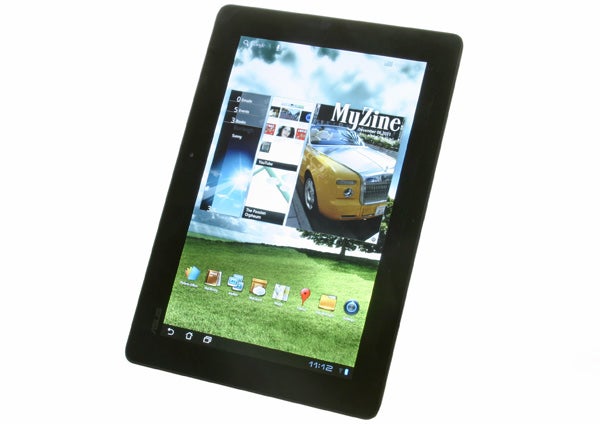
Unfortunately, Android 4.0 – also known as Ice Cream Sandwhich (or ICS for short) – didn’t make it in time for the Prime’s launch. So we’re still stuck with the good old Honeycomb/Android 3.2 we’ve all come to know and love. However, we’ve never seen it running quite this smoothly or quickly before. Though there’s still the occasional judder, it’s now so minor you might not even notice.
Even so, it’s not really fair to judge the latest Transformer on an OS that wasn’t even remotely designed to handle its power, so we’ll give you our final take on the matter once ICS has arrived. Thankfully Asus has promised ICS very soon, and with the Transformer Prime being a development tablet for the latest Android OS, there’s little reason to expect otherwise. In the meantime, we’re glad to report that not just the OS and apps, but also mundane activities like browsing the web, feel just that little bit faster and more responsive.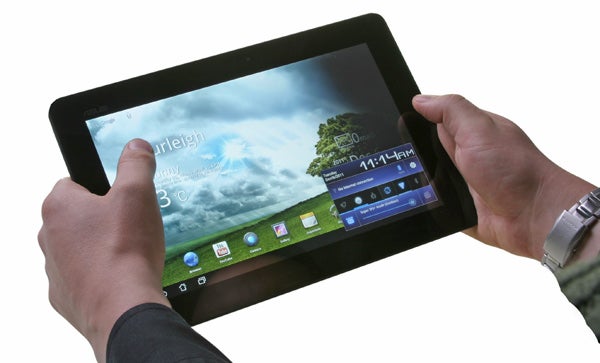
Finally a quick word about included apps. Asus has preinstalled SuperNote, which lets you type with its own virtual keyboard, and draw or write with your finger. The paint tool is actually reasonably sophisticated, certainly a step above the likes of Windows Paint. You can also insert pictures or media files in SuperNote documents, and it lets you record video or voice too.
Many Android users will already be familiar with Polaris Office, which is one of the biggest Office productivity apps for the platform. It accepts most Microsoft Office files and allows for the creation of text documents, spreadsheets and presentations. Though we prefer Documents to Go, Polaris is certainly one of the top two contenders. App Locker provides password protection for individual apps, while App Backup… backs them up to external storage. Asus’ MyCloud, meanwhile, gives access to 8GB of online storage that’s set aside for every Prime owner.
Asus claim up to 18 hours of HD video playback with the Prime’s dock, or 12 hours without. If these numbers seem unlikely for a quad-core tablet, it’s important to remember that, unlike Tegra 2, its successor is a fully scalable architecture. Not only can Tegra 3 dynamically balance load across all four of its main cores (which can clock in at up to 1.4GHz for a single core or 1.3GHz across all), but it can completely turn them off too. Yes, all four of them. You see, there’s actually a fifth ‘companion core’ integrated into the chipset, which can handle idle modes or low-level tasks such as word processing. This unit uses less power than a single ‘regular’ core, allowing Nvidia to accurately claim its latest quad-core chip will consume less power than Tegra 2’s dual-core arrangement (and indeed those of most rival chips) in many scenarios. In other words, anyone who thinks tablets don’t need quad-core, here you get better performance married to better battery life, so there’s no reason for complaint.
Indeed, the Transformer easily matches the best of the competition where battery life is concerned. We measured over nine hours of SD video playback (sans dock), and in a test simulating average use (screen brightness at 50 percent, Bluetooth and Wi-Fi on, some standby periods) the tablet alone managed a whopping 14 hours! Throw in the dock and this extends even further, though battery life won’t double as it did for the original Transformer since the dock’s battery size (and thus capacity) had to be reduced to maintain its slimness. It’s worth pointing out that the dock actually charges the tablet while the two are connected – as long as it has charge to give, obviously, otherwise it drains the device.
So how does Asus’ new Transformer Prime compare to the rest of the market, and perhaps more importantly, to its predecessor (which will continue to be available at a reduced price of around £380 with dock as a budget option)? Well, aside from kicking the stuffing out of Decepticons, the Prime also pretty much beats every other Android tablet out there without exception. The only tablet that offers more versatility than the Prime is Lenovo’s ThinkPad tablet, which includes a pressure-sensitive stylus in addition to a keyboard folio case that’s great to type on. But it’s nowhere near as slim, light, stylish or powerful, nor is its IPS screen as good.
As a tablet, meanwhile, Asus’ second Transformer is thinner and nearly as light in the hand as the Samsung Galaxy Tab 10.1, while offering a brighter screen and far more connectivity, storage and power. And as mentioned in our Transformer Prime VS iPad 2: Battle of the Tablet Titans piece, it beats the mighty iPad 2 in many regards too, especially if you’re more interested in productivity and video playback than app choice and gaming.
The craziest part is that, if the UK MSRP of £499 holds up, it will cost only £20 more than a 32GB iPad 2, and that’s with the keyboard dock included, making it an absolute bargain. 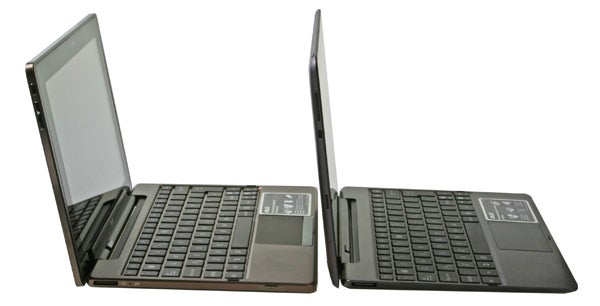
(centre)Here you can see the original Transformer on the left, compared to the Prime on the right.(/centre)
So is the Prime the perfect tablet? Not quite. Until the aforementioned update to ICS arrives, Apple’s iOS still offers a smoother and more attractive tablet OS. Android’s app selection and security is also several levels below what you currently get with the iPad, though this situation is improving. On the hardware front, meanwhile, there’s still no sign of a 3G option in either original or new Transformer. We also feel that despite its better build quality and more attractive design, the dock has taken a few steps back compared to its predecessor: the keyboard is shallower and we really do miss that second full-size USB 2.0 port. If you don’t need the benefits Tegra 3 brings to the table, you might be better off with the £380 original.
However, at just under £500 the Prime’s really a bit of a bargain. It can even be used as a netbook or laptop replacement if you’re happy with its limitations, and dare we say should run Windows 8 beautifully when that OS comes out, expanding its flexibility further.
Verdict
Asus’ Tranformer Prime is a thing of beauty. Despite
being easily as thin and light as most rivals, this aluminium-clad tablet is
far more powerful thanks to its quad-core Tegra 3 internals. This also means
that smooth 1080p video playback on a tablet and console-quality gaming on
Android are finally realities, and the Prime shows them off on the best tablet
screen we’ve yet seen.
The keyboard dock is the icing on a very tasty cake, and
though there are a few concessions compared to the original Transformer’s dock,
it’s still an amazing add-on that not only makes the Prime one of the most
versatile devices on the market, but also one of the longest-lasting. Quite
simply, the Transformer Prime is the best Android tablet available and arguably the best
tablet per se.
How we test tablets
We test every tablet we review thoroughly. We use industry standard tests to compare features properly and we use the tablet as our main device over the review period. We’ll always tell you what we find and we never, ever, accept money to review a product.
Trusted Score
Score in detail
-
Performance 9
-
Design 9
-
Screen Quality 9
-
Value 10
-
Features 9
-
Battery Life 9

